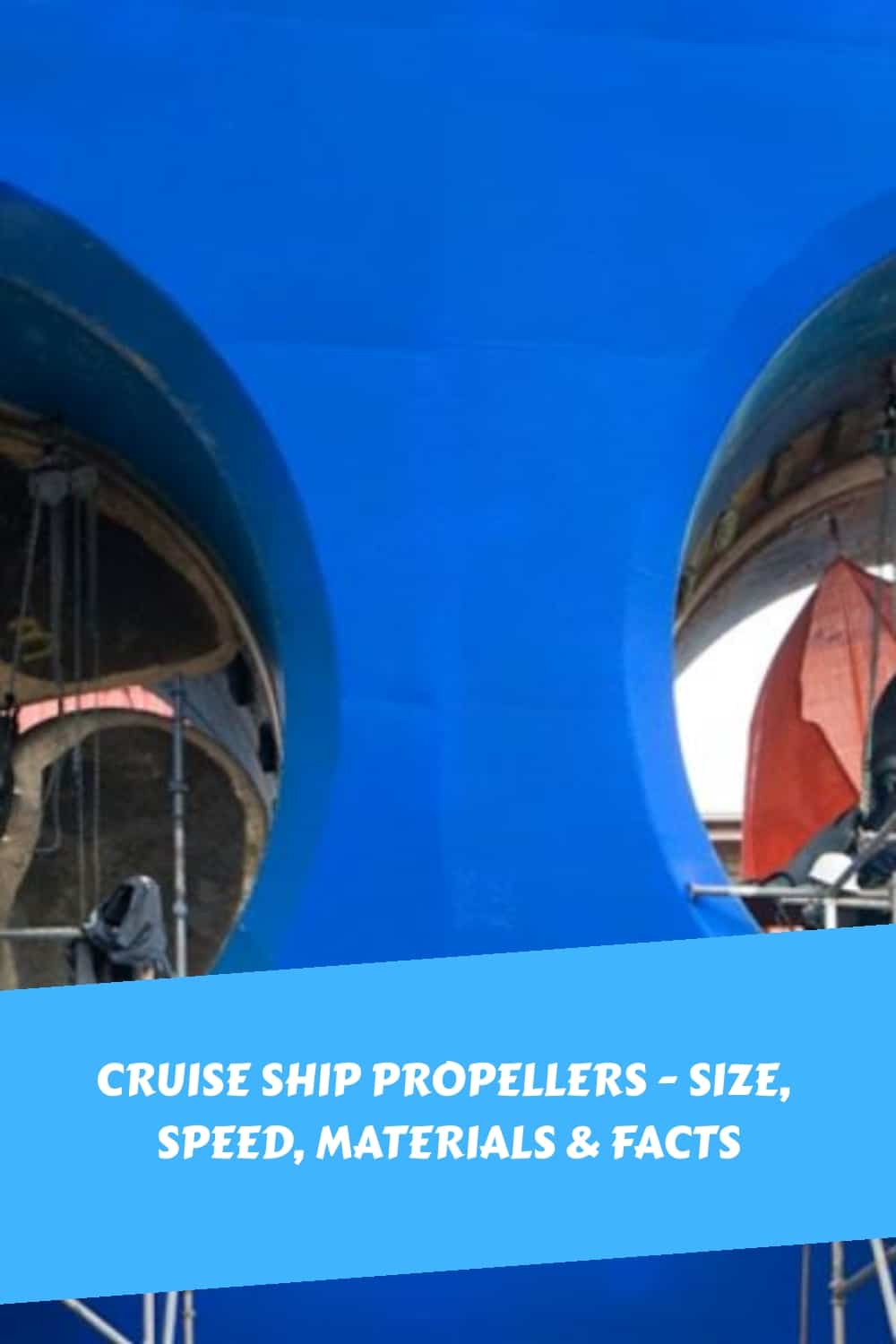Cruise ships are floating cities – so how on earth do they glide through the water with such precision? And what about those massive propellers underneath… are they dangerous?
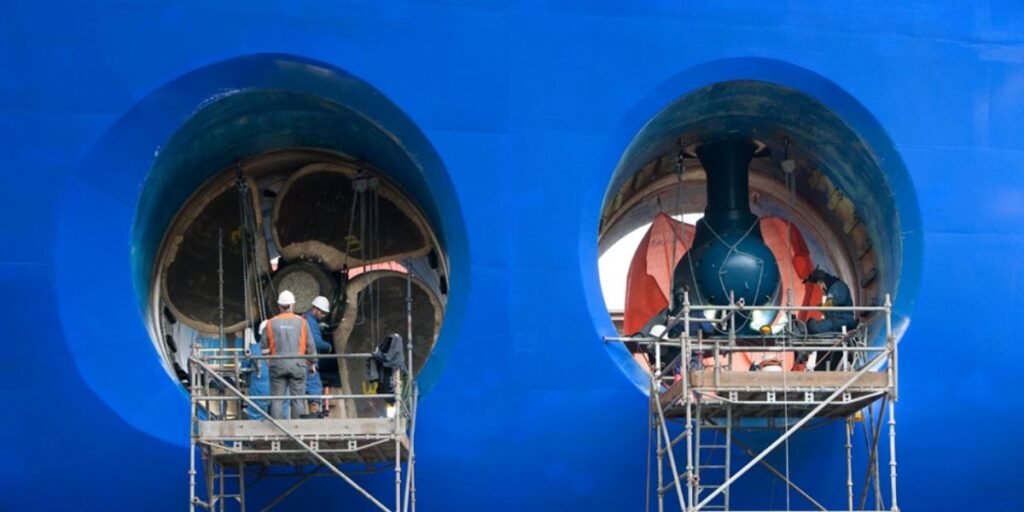
If you’ve ever wondered how cruise ships stay on course (or you’re worried about getting too close to a propeller), this guide is for you. We’ll uncover the fascinating engineering behind cruise ship propulsion, reveal just how big those propellers really are, and clear up any myths about getting pulled under.
How Big A Cruise Ship Propeller Is
Cruise ship propeller sizes can vary, but the biggest are approximately 20 feet (6 metres) in height. Due to the size of the propellers, the bottom of a ship tends to lift up towards the rear so that the propellers don’t sit below the bottom of the ship.
Here’s what one of the biggest cruise ship propellers looks like…
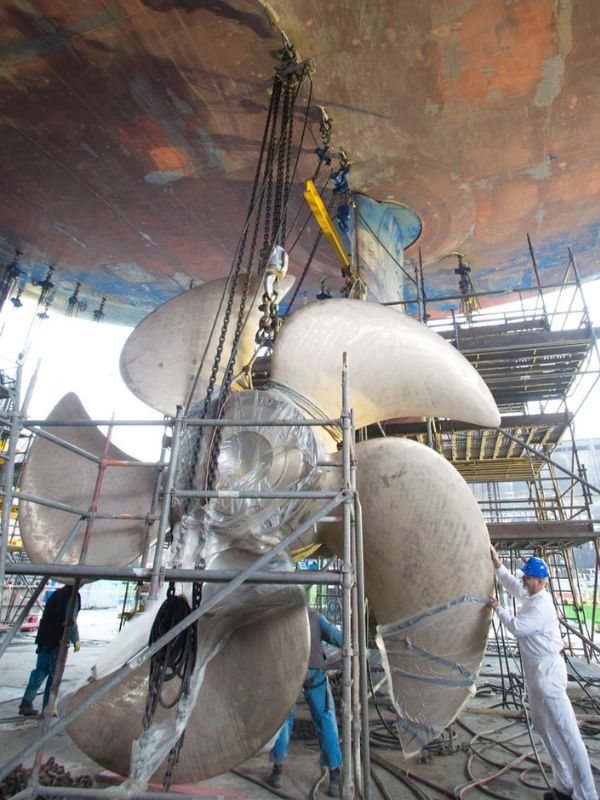
The shape of the bottom of a cruise ship with the raised rear helps to propel the ship forward. It also ensures that the propeller doesn’t have a huge impact on the ship’s draft. If the propellers protruded from the very bottom of the ship, then it would struggle to get to most ports due to the lack of depth of the water.
Most modern cruise ships use azimuthing pods (azipods). They work by having the propeller at the front of the pod, rather than the back, so they actually pull the ship rather than pushing it. They have a reverse function and can spin 360 degrees to help with steering.
This photo shows the azipods on Radiance of the Seas during drydock.
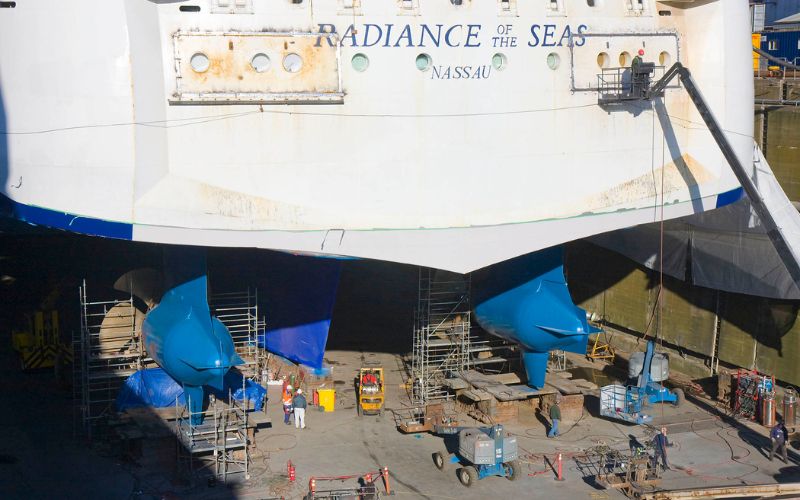
An azipod is like a propeller and a rudder all in one. If you’re wondering whether cruise ships still have rudders, read this article for the answer from a ship’s pilot.
We know that the biggest propellers are 20 feet in height, but that can be quite hard to picture. But if it helps, a typical two-storey house is around 19 feet tall, while a giraffe will average at around 18 feet tall (but can sometimes grow to 20 feet tall).
That should make it a little easier to understand just how large these propellers are!
They’re not the biggest in the world, though. Those tend to belong to container ships – just imagine how much power is needed to push a giant ship full of heavy containers. The MSC Oscar has propellers that are 10.5 metres or approximately 35 feet in diameter.
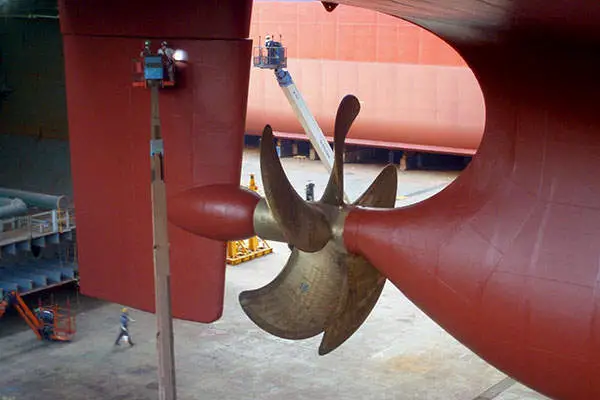
That’s almost 43% bigger than those on the Oasis-class ships for Royal Caribbean, despite the ship only being 9% longer.
How Many Propellers Cruise Ships Have
Most cruise ships have three propellers, while generally, ships will have between one and four. Cruise ships use three propellers due to the balance they offer between fuel consumption, thrust, and manoeuvrability.
The number of propellers a ship has will determine how fast the ship is, how much fuel it needs to use to move, and how easy it is for the ship to turn.
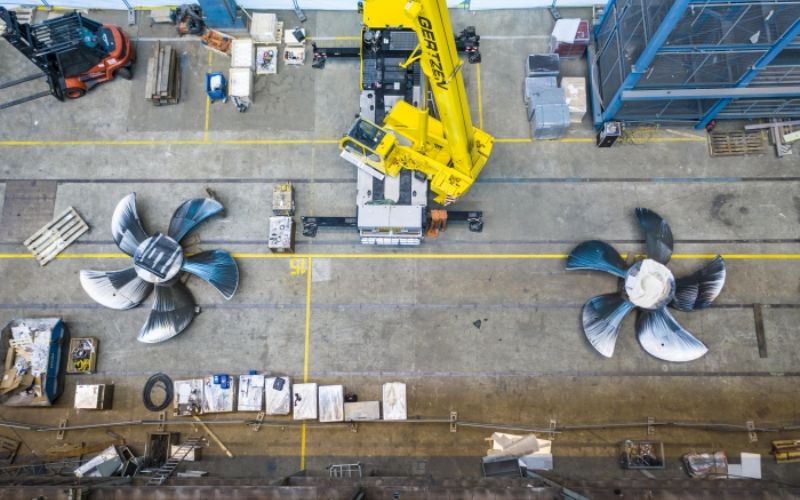
The largest freighter ships in the world may only have one propeller. They tend to take long journeys in a relatively simple direction, they are built to withstand storms, so don’t necessarily need to move around them, and there isn’t a massive rush to get to the destination.
Cruise ships need more manoeuvrability. It’s not good to power through a storm when you have guests onboard who are trying to enjoy a relaxing cruise, and ships tend to weave in and out of the coastline as they visit different ports, so it’s important that the ships can steer effectively.
They also need to move relatively quickly. Not super-fast speeds, but fast enough to be able to reach a selection of ports within an itinerary. Otherwise, most cruises would have two sea days in between every port you visited!
Three azipod propellers are generally the accepted number for most modern cruise ships. Four isn’t really necessary, and three helps to keep the fuel consumption in check while providing plenty of power and steering to make cruises comfortable.
Also, they typically have four blades – propellers typically have between three and five, but the azipods used on most cruise ships have four. More propellers can improve performance, but for a cruise ship, it’s not necessary.
The benefits of a four-blade propeller are:
- Lower manufacturing costs than a five-blade propeller
- Good performance at low speeds
- Best fuel economy compared to three-blade and five-blade propellers
- Better durability than five-blade propellers
How Fast A Cruise Ship Propeller Spins
Cruise ship propellers typically spin at a speed of 250 revolutions per minute (RPM). This isn’t extremely fast when compared to some other propellers – there is more of a focus on torque and power in order to push a massive ship through the water.
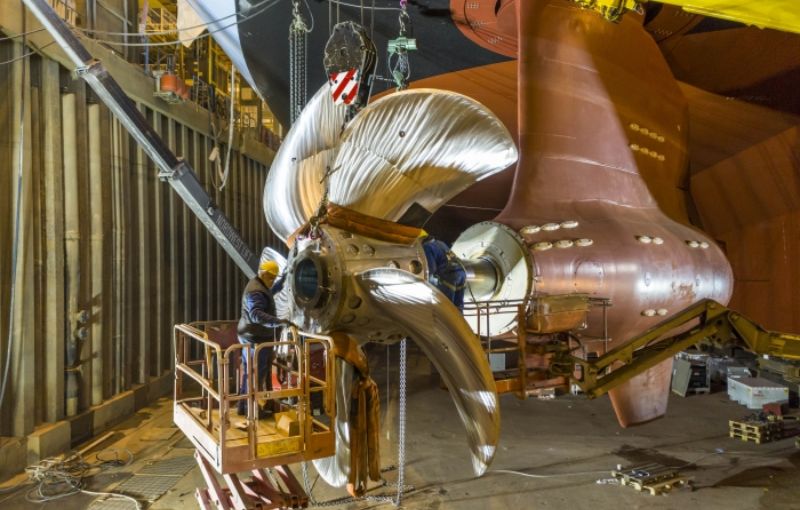
Remember that these propellers are in the ocean, not in the open air. That means there is a lot more resistance. If you put the same propellers, with the same engine power, in an open-air space, they would be capable of spinning a lot faster.
Again, it’s hard to visualise how fast 250 revolutions per minute is. But if you can picture it, it means that the fan blades of the propeller are completing a full revolution around four times every second.
Still need help? Well, a ceiling fan will typically have an RPM of between 200 and 350. So, if you live somewhere that has ceiling fans, try putting it on the slowest setting, and you’ll be able to get an idea of how fast a cruise ship propeller spins.
Or you can use this cool tool just to visualise it – just enter 250 in the box to see how it looks in action.
What Cruise Ship Propellers Are Made Of
Cruise ship propellers, just like any propeller used on a modern ship, are made from an alloy of stainless steel and aluminium. This provides the necessary strength to be able to move through the water, and it is resistant to rust, too. It’s also light enough not to increase the drag on the ship.
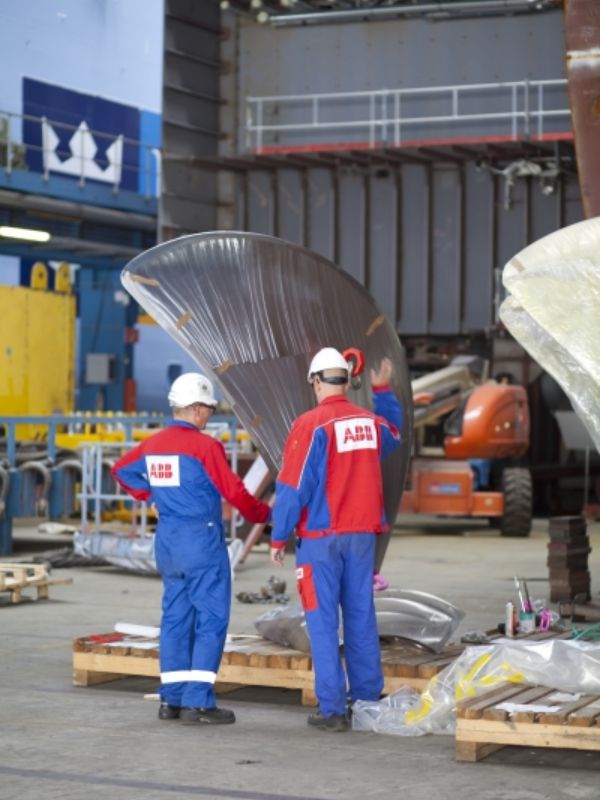
The propellers of a cruise ship spend their life in the water – unless they go into a dry dock for cruise ship repairs or renovations. So it’s vital they can stand up to corrosion and the other forms of degradation that water can impose.
An alloy of stainless steel and aluminium won’t rust, and will be durable enough to withstand the constant demands of a giant cruise ship at cruising speed.
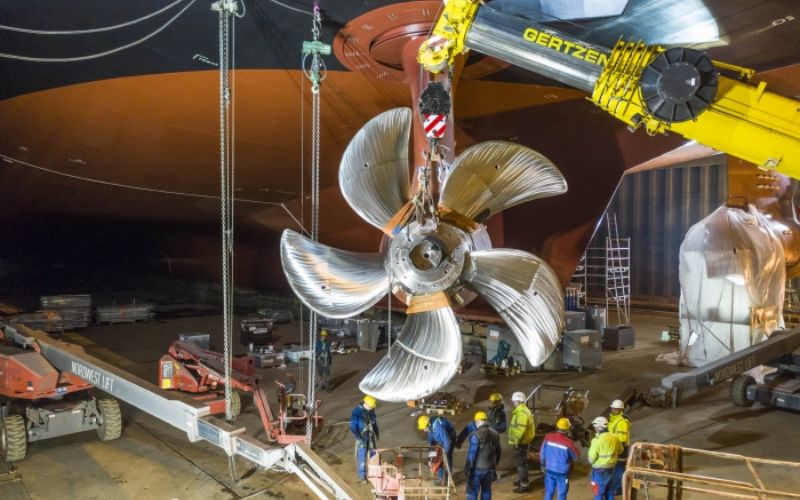
Myth Or Fact: Cruise Ship Propellers Can Pull You Under
It is possible for a cruise ship propeller to pull you under, but the odds are very low. You would have to be swimming directly alongside the ship, towards the aft where the propellers are located, or directly behind it, and even then, the depth is usually enough to protect you.
You have to remember that cruise ship propellers don’t sit on the waterline – they are submerged, and are typically at least 10 feet under the water. Therefore, the drag at the water level is lessened, but not completely removed.
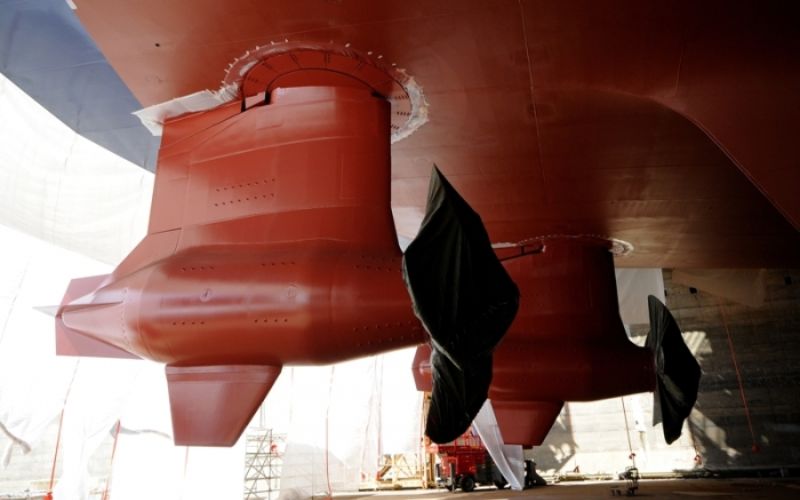
If you were to jump off a cruise ship and dive a few feet under the water due to your momentum, you could get caught in the slipstream. But remember how unlikely that is.
And if you stay at the surface, treading water, you would need to be almost touching the ship to be at risk of being pulled under.
While people do go missing on cruise ships, the odds of falling overboard on a cruise ship are around one in a million, based on the number of incidents and the number of cruise passengers (source). And many of the incidents recorded are due to people jumping rather than falling.
These facts about cruise ship propeller drag don’t mean it’s safe to swim over to a cruise ship if you see one in a dock, though. You never know when the engines could kick in and cause a sudden current shift, and that would increase your risk.
In summary, if you are sensible on or near a cruise ship, you shouldn’t have anything to worry about. But don’t take risks if you see a cruise ship in port and fancy getting a closer, water-level view.
Final Word
Cruise ship propellers are absolutely massive, but they, of course, have to be in order to propel these mammoth cruise ships through the water.
They’re incredible pieces of engineering, with the latest Azipods being much more efficient too, which contributes to the way that ships are being designed to be better for the planet, with changes to cruise ship engines and fuel types too.
Don’t panic about going overboard either – the odds of that happening are extremely low, and even then, the odds of being sucked under by the propellers are minuscule. Cruises are very, very safe!
TODAY’S BEST CRUISE DEALS!
Don’t miss these offers…
Related Posts:
- How Many Cruise Ships Have Sunk?
- How Do Cruise Ships Float And Not Tip Over?
- How Long Does It Take To Build A Cruise Ship?

Jenni Fielding is the founder of Cruise Mummy. She has worked in the cruise industry since 2015 and has taken over 30 cruises. Now, she helps over 1 million people per month to plan their perfect cruise holidays.

